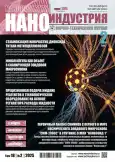Study of structure and properties of nanosized molybdenum oxide stabilized by hydroxyethylcellulose
- Authors: Nagdalian A.A.1, Filippov D.D.1, Rekhman Z.A.1, Serov A.M.1, Povetkin S.N.1, Lyubchansky N.S.1
-
Affiliations:
- North-Caucasus Federal University
- Issue: Vol 18, No 2 (2025)
- Pages: 116-125
- Section: Nanotechnologies
- URL: https://journals.eco-vector.com/1993-8578/article/view/678955
- DOI: https://doi.org/10.22184/1993-8578.2025.18.2.116.125
- ID: 678955
Cite item
Abstract
In this work, samples of nanoscale molybdenum oxide stabilised by hydroxyethylcellulose were prepared by sol-gel method. Scanning electron microscopy microstructure studies showed that the hydroxyethylcellulose-stabilised molybdenum oxide sample is represented by irregularly shaped aggregates ranging in size from 4 to 75 μm, which consist of nanoparticles with diameters ranging from 30 to 60 nm. As a result of computer quantum-chemical modelling of interaction between hydroxyethylcellulose and molybdenum oxide, it was found that the presented compound is energetically advantageous (∆E ≥ 4022.388 kcal/mol) and interaction occurs through the hydroxyl group attached to the C2 residue of glucopyranose. This compound has a chemical rigidity value of 0.078 eV ≤ η ≤ 0.082 eV, indicating its stability. By IR spectroscopy, it was found that interaction between hydroxyethylcellulose and molybdenum oxide occurs through the hydroxyl group.
Full Text
About the authors
A. A. Nagdalian
North-Caucasus Federal University
Email: zafrehman1027@gmail.com
ORCID iD: 0000-0002-6782-2821
Cand. of Sci. (Tech), Docent
Russian Federation, StavropolD. D. Filippov
North-Caucasus Federal University
Email: zafrehman1027@gmail.com
ORCID iD: 0000-0003-1997-6583
Laboratory assistant
Russian Federation, StavropolZ. A. Rekhman
North-Caucasus Federal University
Author for correspondence.
Email: zafrehman1027@gmail.com
ORCID iD: 0000-0003-2809-4945
Assistant
Russian Federation, StavropolA. M. Serov
North-Caucasus Federal University
Email: zafrehman1027@gmail.com
ORCID iD: 0009-0001-2929-4191
Laboratory assistant
Russian Federation, StavropolS. N. Povetkin
North-Caucasus Federal University
Email: zafrehman1027@gmail.com
ORCID iD: 0000-0002-8293-3984
Leading engineer
Russian Federation, StavropolN. S. Lyubchansky
North-Caucasus Federal University
Email: zafrehman1027@gmail.com
ORCID iD: 0009-0006-4512-8085
Student
Russian Federation, StavropolReferences
- Сизова Е.А., Мирошников И.С. Особенности обмена химических элементов в организме животных при внутримышечном введении наночастиц элементарного железа // Животноводство и кормопроизводство. 2014. № 3 (86). С. 80–84.
- Сизова Е.А. и др. Наночастицы меди-модуляторы апоптоза и структурных изменений в некоторых органах // Морфология. 2013. Т. 144. № 4. С. 47–52.
- Yausheva E., Sizova E., Miroshnikov S. Evaluation of biogenic characteristics of iron nanoparticles and its alloys in vitro // Modern Applied Science. 2015. Т. 9. № 10. С. 65.
- Lebedev S. et al. Impact of Zn nanoparticles on growth, survival and activity of antioxidant enzymes in Eisenia Fetida // Modern Applied Science. 2015. V. 9. No. 9. P. 34.
- Kosyan D.B. et al. Toxic effect and mechanisms of nanoparticles on freshwater infusoria // GEOMATE Journal. 2016. V. 11. No. 23. PP. 2170–2176.
- Сизова Е.А. и др. Влияние сульфата и наночастиц железа на особенности обмена химических элементов в мышечной ткани // Ученые записки Казанской государственной академии ветеринарной медицины им. Н.Э.Баумана. 2014. Т. 217. № 1. С. 251–255.
- Бельмер С.В., Гасилина Т.В. Микроэлементы и микроэлементозы и их значение в детском возрасте // Вопросы современной педиатрии. 2008. Т. 7. № 6. С. 91–96.
- Дыгова М.Р., Кубалова Л.М. Биологическая роль молибдена // Международный студенческий научный вестник. 2015. № 3–4. С. 550–551.
- Балыкин Д.Н., Пузанов А.В. Марганец, медь, молибден и бор в почвах среднегорных котловин Алтая // Мир науки, культуры, образования. 2007. № 4. С. 27–30.
- Павлов С.В., Дубровский О.И., Домашевская Э.П. Расчет электронной структуры орторомбической модификации триоксида молибдена // Физико-химические процессы в конденсированных средах и на межфазных границах (Фагран-2018). 2018. С. 316–319.
- Музафарова С.А., Ташланова Д.М. Свойства тонких пленок триоксида молибдена MoO3, полученные методом химического осаждения из паровой фазы в потоке водорода // Научные исследования. 2024. С. 169–176.
- Боборико Н.Е. Золь-гель синтез наноразмерных композитов TiO2–MoO3 для химических газовых сенсоров // VII Всероссийская конференция по наноматериалам. 2020. С. 49–50.
- Mai L. et al. Molybdenum oxide nanowires: synthesis & properties // Materials today. 2011. V. 14. No. 7–8. PP. 346–353.
- Alsaif M.M.Y.A. et al. Substoichiometric two-dimensional molybdenum oxide flakes: a plasmonic gas sensing platform // Nanoscale. 2014. V. 6. No. 21. PP. 12780–12791.
- Reichwein H.G. et al. Light, strong and economical–epoxy fiber-reinforced structures for automotive mass production // Proceeding of SPE automotive composites conference & exhibition. 2010. PP. 1–20.
- Ernst-Siebert R., Grasser S. Mass production of composite leaf springs // Lightweight Design Worldwide. 2018. V. 11. PP. 18–21.
- Афанасьев Б.А., Даштиев И.З. Проектирование элементов автомобиля из полимерных композиционных материалов: учеб. пособие / Под ред. Б.А.Афанасьева. М.: Изд-во МГТУ им. Н.Э.Баумана. 2006.
- Арис П.В.Ф.А., Лусварди К.М., Нгуйен Т.Т. Замещенная в массе гидроксиэтилцеллюлоза, ее производные, способ ее получения и применение. Патент RU2410403C2, 2011.
- Бородкина Т.В., Бежанишвили А.Е., Смагина В.В. Средство для лечения ран, Патент RU2404751C2, 2010.
- Косенок Я.А. и др. Разработка новых гидрофобизирующих эмульсий для производства теплоизоляционных материалов с улучшенными эксплуатационными характеристиками, Международная юбилейная научно-практическая канференция, посвященная 90-летию гомельского государственного университета имени Франциска Скорины, 2020.
- Материалы конференции. В 3-х частях. Том Часть 3. Редколлегия: С.А. Хахомов (гл. ред.) [и др.]. Гомель, 2020 2020.
- Rodrigues Filho G. Characterization of methylcellulose produced from sugar cane bagasse cellulose: Crystallinity and thermal properties [Текст] / G. Rodrigues Filho [et al.] // Polymer degradation and stability. 2007. V. 92. No. 2. PP. 205–210.
- Ragab H.S. Optical and thermal studies of starch/methylcellulose blends [Текст] / Ragab H.S. , Abd El-Kader M.F.H. // Physica Scripta. 2013. V. 87. No. 2. P. 025602.
- Nik Aziz N.A. Solid polymer electrolytes based on methylcellulose: FT-IR and ionic conductivity studies [Текст] / Nik Aziz N.A., Idris N.K., Isa M.I.N. // International journal of polymer analysis and characterization. 2010. V. 15. No. 5. PP. 319–327.
- Ali M.S. Transdermal therapeutic system: Study of cellulose nanocrystals influenced methylcellulose-chitosan bionanocomposites [Текст] / M.S.Ali [et al.] // International Journal of Biological Macromolecules. 2022. V. 218. PP. 556–567.
- Abdel-Halim E.S. Chemical modification of cellulose extracted from sugarcane bagasse: Preparation of hydroxyethyl cellulose [Текст] / E.S.Abdel-Halim // Arabian Journal of Chemistry. 2014. V. 7. No. 3. PP. 362–371.
Supplementary files










